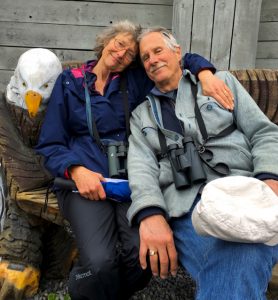
of images from this part of our journey.
“Would you want to live here?” Sooney asked. I don’t remember what inspired the question but I’ve come to grips with the immensity—and extremes—characterizing Alaska. Weather patterns, scenery, lifestyle—we’ve seen a good portion of it in our nearly 2-month road trip. The short answer is “No.” But a younger person might feel differently. One of the guides on our wonderful adventure in Glacier Fjord National Park spends summers working at the lodge and winters as a ski bum in Big Sky, Montana. Before that he guided in Hawaii for 5 years. He’s 26, healthy, intelligent, curious, and highly skilled at what he does. I’m 71 and claim similar attributes. Furthermore, I’ve grown comfortable with a calmer agenda. Sooney and I continue to enjoy our pop-up camper and, as of this writing, we hit #322 nights spanning the 10 years we’ve had it. We’re also aware of the enormous difference between one-night stays and multiple nights in single locations. Slow down, kick back, and soak it all in. Not a bad approach to living as well.
Our Kenai peninsula experience was mixed. Weather and crowds diminishing the bliss we’d experienced at Kenai Fjord Lodge in the National Park. The ensuing 2-weeks were a bit more pedestrian although hardly uneventful. From Seward, the road to Homer is a dead end and we let the predictable afternoon (and often all night) rains dictate where and how long we camped. Initially the weather was pleasant and we enjoyed our introduction to “combat fishing” on the Kenai River. While it sounds physical, this silly term refers to hundreds of shore-based anglers wading 10-15’ from each other and doing their damnedest to keep their lines untangled. The river was loaded with Sockeye (Reds) and red they were. About every other cast was rewarded with a fish and, when beached, the fisher had to make a decision: too red, let it go to spawn. Snagged from the gills south? Let it go. Some silver? Keep it if you’re into harvesting food. The limit for Alaskans is 32 fish a season but one guy said he’d recently pulled his 16th (and final) fish from the freezer just in time to start all over again. We noticed most of the fish were released and caught for sport. Didn’t look like fun so I didn’t participate.
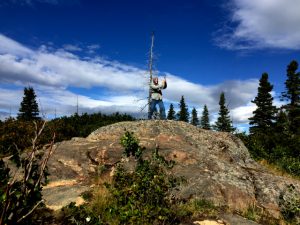
Another tactic is to hire a guide and drift down the Kenai from Cooper Landing to Skilak Lake. This is ostensibly fly fishing at its best and includes casting stops to work a guide’s special hole. The lower Kenai winds through stunning canyons that are a fair distance from the Seward Highway so anglers have these beautiful waters mostly to themselves. Eventually the Kenai flows into the lake and guides pull out their motors for an often windy mile or so to Lower Skilak Campground and its boat ramp. This was our campsite for a couple nights and the birding was active as were the shuttle vehicles schlepping boats and clients back to Coopers. A bit noisy in the afternoon with occasional moans about how lousy the fishing was, it was all ours in the evening. A challenging 1.5 mile trail from camp to an overview seemed much longer as we climbed up, and up, and more up yelling “Hey Bear” around every bend. When we finally reached our windy destination, we were rewarded with a rare sunset before scrambling down to an early dinner and similarly early departure the following morning to reconnect with Marty & Terry on the Russian River.
The Russian River is clear water that flows into the Kenai. The campground is lovely, spacious, and reasonably private. There is a stair case, mind you, leading to the shallow 30’ wide river and a plastic boardwalk paralleling a restoration project encouraging native plants to flourish. Every so often the boardwalk opened to the river providing safe access for anglers. I think some planner made a serious attempt to adapt ADA compliance to a fishing stream as a good quarter mile of the river was easily wheelchair accessible. I didn’t see a single one, however, and meandered along in the afternoon alone, sharing the gorgeous sunlight with cottonwoods, alder, and the ubiquitous black spruce. Fall was in the air. Small warblers, sparrows, and chickadees ignored me as they devoured their dinners of yummy bugs and other goodies. Another fishing opportunity missed but, hey, the local Safeway sells fresh-caught Sockeye for peanuts and I had Sooney’s hand-me-down binoculars.
Persistent rain dictated a straight shot to Homer and its celebrated “spit”, a narrow 4.4-mile stretch of beach, marinas, RV parks, bars, and other touristy attractions. We’d been alerted about a couple not-to-be-missed destinations—the Pratt Museum and Two Sisters bakery—and after a 2 hour drive in traffic we understandably began with the bakery. The next day our second visit to the bakery allowed us to entertain Art, a jewelry artist and long-time acquaintance of our next-door neighbor in Ashland. He has limited his jewelry to contract work and is the facilities supervisor at the museum. He applies his metalworking skills to building custom hangers for the museum’s extensive collection of skulls, native tools, etc. and treated us to a rare, behind-the-tank visit to the salt water marine display. After Art scraped several starfish off the glass, I was creeped out when an octopus hung onto the tank’s edge, reaching for my camera as if it, or even worse, I, was dinner.
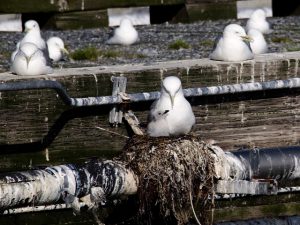
We camped on the spit at the Mariner’s RV park, a municipally-owned graded stretch of oceanfront featuring 2 Porta-Potties and hundreds of rain-filled potholes. One shouldn’t complain, however, when backed up to a sunset on a clean beach. Again we were reminded how the extreme tides affect bays and inlets. Within 6 hours, we experienced wind-swept waves crashing on the beach just beneath us to having to use binoculars to make out distant beach-combers at low-tide. After a night of steady, cacophonous rainfall (our camper’s aluminum roof is about 24” from our heads) Sooney arose with animated anticipation of a guided birding outing up the bay. My choice was to pack up our stuff and move to higher ground, another municipally-owned campground on a bluff overlooking town. It rained all day and night with no apparent affect on Sooney’s wonderful birding trip. Lucky me.
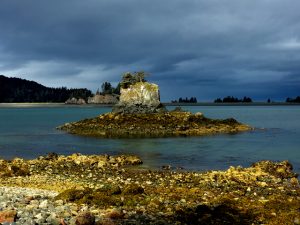
Prior to arriving in Homer, we booked an overnight at Seldovia’s Boardwalk Hotel, across the bay and accessible only by air or sea. Opting for the the ferry, we arrived to a lovely protected fishing community complete with a receptionist sea otter. We stretched our legs in pursuit of feathery entertainment and, after a stroll through the historic boardwalk part of town, ended up on the hotel’s patio overlooking the marina for cocktails and dinner. The next morning, we followed a tip to hike the “Otterbahn”, a 1.5-mile trail through dense forest and a collaborative effort of the local middle and high school students. The trail leads to a camping beach with a zillion smooth stones and passes through old-growth trees and is illustrated with interpretive signs explaining the relationship between trees and wooden boats. We’ve seen a lot of old wooden boats on this trip, many relegated to a distant third place behind fiberglass hulls and, more recently, aluminum boats. Sadly, throughout the marine chapter of our journey, wooden boats and mildewed RV’s have often become common afflictions to pastures, roadsides, and otherwise scenic panoramas. And I thought rusty ol’ junked cars were an eyesore!
We headed back up the same way we arrived with an entertaining layover in Anchor River State Park. In addition to Sooney finally seeing Arctic Terns up close, it was amusing to see charter guides take their clients halibut fishing. Tractors with huge tires hooked up to boat trailers bearing 25’ halibut boats, crew and clients holding on, and pushed them backward into the surf. At just the right moment, the boats floated away from their trailers, the skippers powered up dual outboards, and away they went into the fog-shrouded Cook inlet. When finished, they idled off shore while the tractors selected the correct trailers from the lineup and plodded through kelp and annoyed sea birds back into the surf. Again, at just the right moment, the skipper powered up his outboards and mounted the trailer where a skilled assistant secured the boat for its ride back to the parking lot and charter vans. I noticed the first thing the dismounting skipper did was compensate that hand for yet another safe trailering. Good job Skipper.
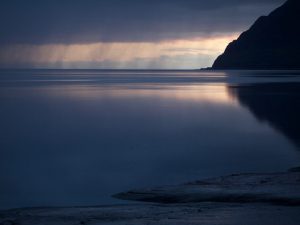
The drive to Anchorage was interrupted by wet overnights at Portage Glacier and ditto at Bird Creek State campground (although the latter served up an epic sunset over Turnagain Arm). What followed was another classic Viani pack-it-all-in-a-day Anchorage experience. We started with our second visit to Potter Marsh, (the first was in a downpour), and followed that up with a great lunch at Sacks on 3rd Ave. (It actually used to be on 5th!). From there we biked the Tony Knowles trail beginning at Westchester Lake and cruised well south of the airport where we saw some Sandhill cranes and our moose. We took that as a sign and cycled back to town and a great experience at the 49th State brewery in downtown Anchorage. Just after watching Katie Lepke win Olympic gold in the 200m freestyle we gassed up, shopped for food at Fred Meyers and drove 15 miles north of town to surprise Marty & Terry at Eagle River CG. There’s been a lot of surprises on this road trip.
This journey has been a combination of spontaneous last-minute decisions and chiseled-in-stone reservations (e.g. ferry transportation, lodge bookings, etc.). Our upcoming 7 nights in Denali National Park (reservations made months earlier) are the final appointments on our calendar. From there we’ll wing it south playing tag with fall colors (we hope) before snow sets in. We’re looking forward to dropping in on Sooney’s brother in Yaak Montana before returning home to Ashland. But that’s a month away and we’ve got Northern Lights to experience. We’re still looking for the Hawk Owl and some other birds, by the way. (I wouldn’t be disappointed in a couple of stars as well.) Stay tuned.
Birds and critters spotted along this leg of our journey:
Skilak Lake
Red-breasted Nuthatch, *Boreal Chickadee, Gray Jay, American Creeper, White-crowned Sparrow, Dark-eyed Slate-colored Junco, Golden-Crowned Kinglet, White-winged Crossbill
Russian River CG
Bald Eagle, Glaucous-Winged Gull, Boreal Chickadee, Varied Thrush, Orange-crowned Warbler, Townsend Warbler, Dark-eyed Slate-colored Junco, Fox Sparrow
Watson Lake near West Fork of Moose Creek, Kenai Peninsula
Common Loon, American Pipit, Dark-eyed and Slate-colored Junco
Homer
Merlin, Black-billed Magpie
Birding morning with Bay Excursions to Glacier Spit, Humpy Creek, and Gull Island
Harlequin Duck, Surf Scoter, Bald Eagle, *Long-tailed Jaeger, *Short-tailed Shearwater, Marbled and Kittlitz’s Murrelet, Pelagic Cormorant, Tufted Puffin, Pigeon Guillemot, Black Oystercatcher, *Black Turnstone, Glaucous-winged Gull, Bonaparte’s Gull
Humpback Whale, Sea Otters
Seldovia
Mallard, Harlequin Duck, Bald Eagle, Chestnut-backed Chickadee, Northwest Crow, Black-billed Magpie, Stellar’s Jay, Golden-crowned Kinglet, Red-breasted Nuthatch, Belted Kingfisher, Varied Thrush
Halibut, CG, Anchor River State, Rec. Area (Anchor Point)
Arctic Tern, Mallard, Harlequin Duck, Common Merganser, Belted Kingfisher
Glaucous-winged Gull, Black-legged Kittiwake, Greater Yellowleg, American Kestrel
Bird Creek CG
Black-capped Chickadee, Wilson’s Warbler, Yellow Warbler, Orange-crowned Warbler, Black-billed Magpie, Dark-eyed Junco
Turnagain Arm Trail
Dark-eyed Junco, Downy Woodpecker, Blacked-capped Chickadee
Potter Marsh
Mallard, Green-winged Teal, American Widgeon, Greater Yellow legs, Wilson’s Snipe, Herring Gull
Anchorage , Tony Knowles Bike Path/Trail
Red-necked Grebe, Mallard, Greater Scaup, Bonaparte’s Gull, Short-billed Dowitcher, Sandhill Crane, Wilson’s Warbler, and a Moose
4 Life birds (16 total for the entire Alaska road trip)
